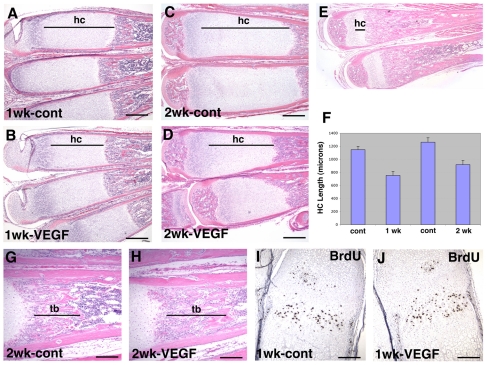Fig. 3.
Treatment with VEGF rescues endochondral ossification defects in MMP-9 −/− mice. (A–D) H&E-stained sections of metatarsals of 1-week-old MMP-9−/− mice treated for 1 week (A,B) or 2 weeks (C,D) with either vehicle or recombinant human VEGF165, showing shortening of the HC zone (hc) in VEGF-treated mice (B,D) compared with vehicle-treated mice (A,C). (E) H&E-stained section of 3-week-old WT metatarsals showing the size of the normal HC zone (hc). (F) Bar graphs of the mean and standard deviation of the HC zone lengths of six vehicle- and VEGF-treated bones after 1 and 2 weeks of treatment; the differences between control and treated samples at each time point were significant (P<0.01). (G,H) H&E-stained sections of the metatarsals of MMP-9−/− mice treated for 2 weeks with either vehicle (G) or VEGF (H) showing lengthening of the trabecular bone region (tb) in VEGF-treated mice. (I,J) BrdU labeling of proliferating cells in the metatarsal growth plates of 1-week-old MMP-9−/− mice treated for 1 week with VEGF. BrdU-positive cells stain brown. Bars, 400 μm (A–D); 200 μm (G,H); 100 μm (I,J).

